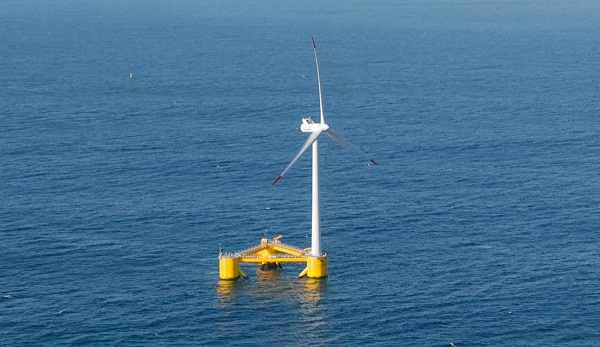The U.S. Department of Energy is kicking off a competition of sorts to drive down offshore wind energy costs, and in doing so it’s turning the focus – a bit, at least – away from the East Coast, where nearly all the action has been taking place in recent years.
The DOE said on Wednesday that seven “advanced technology” demonstration projects would receive up to $4 million apiece for engineering, site evaluation and planning work, after which perhaps three of the projects could be selected for additional funding – worth $47 million over four years – that could help put them in commercial operation by 2017. Four of the projects are off the East Coast, but one is in the Gulf of Mexico, another is on Lake Erie and, perhaps most intriguingly of all, one is a floating turbine project aimed for the waters off Coos Bay, Ore.

The company behind the Oregon project is Seattle-based Principle Power, which late last year was in on the successful deployment of a floating turbine off the Portugal coast. Principle calls its platform design WindFloat, and touts the benefits of anchoring turbines far offshore, where the winds can blow stronger and more consistently but where waters are too deep for conventional turbine structures.
Another key benefit of going farther offshore: less conflict, according to Elise Hamner, communication manager for the Oregon International Port of Coos Bay. Hamner confirmed that the port has been working on an offshore wind energy concept with a private company, though she couldn’t name the company because of a nondisclosure agreement. She said that compared to near-shore wave energy projects that have run into concern if not opposition from the fishing industry, deep-sea offshore wind “could go a lot more smoothly.”
But there is another aspect of Principle’s Coos Bay proposal that could still be controversial: It hinges on development of a liquefied natural gas terminal at the port. That’s because the turbine assembly and launch facilities envisioned as part of the port’s concept could only be viable as part of the larger development of the LNG infrastructure.
That proposal, the Jordan Cove Energy Project, has been unfolding for nearly a decade, first as a terminal to import LNG, now – after the U.S. shale gas boom – as an export terminal, and is enmeshed in a complex permitting process, with apparently energetic opposition. So we’ll see what happens there.
All six of the other projects that will compete for the three possible slots in the next round of this process include some form of innovative foundation, including two that would use floating turbines and that we’ve heard about before – Statoil’s proposed project in the Gulf of Maine, and the University of Maine’s project near Monhegan Island, which we wrote about just a couple of days ago.
As for the others: The Gulf of Mexico project, in state waters near Port Isabel, Texas, offers “an advanced jacket foundation design,” the DOE said; the Fishermen’s Atlantic City Wind Farm three miles off New Jersey’s coast – which might be the project that’s farthest along – will use “advanced bottom-mounted foundation design and innovative installation procedures to mitigate potential environmental impacts”; and the Lake Erie project “plans to install nine 3-megawatt direct-drive wind turbines on ‘ice breaker’monopile foundations designed to reduce ice loading” seven miles out from Cleveland.
One last note about this DOE program: The first round of funding for the seven companies is a done deal, but the bigger, second-round would be contingent on Congress making the money available in future budgets.